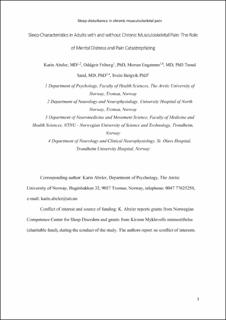| dc.contributor.author | Abeler, Karin | |
| dc.contributor.author | Friborg, Oddgeir | |
| dc.contributor.author | Engstrøm, Morten | |
| dc.contributor.author | Sand, Trond | |
| dc.contributor.author | Bergvik, Svein | |
| dc.date.accessioned | 2021-03-19T14:27:15Z | |
| dc.date.available | 2021-03-19T14:27:15Z | |
| dc.date.created | 2020-09-22T09:45:34Z | |
| dc.date.issued | 2020 | |
| dc.identifier.citation | The Clinical Journal of Pain. 2020, 36 (9), 707-715. | en_US |
| dc.identifier.issn | 0749-8047 | |
| dc.identifier.uri | https://hdl.handle.net/11250/2734555 | |
| dc.description.abstract | Objectives: Sleep disturbance is associated with persistence and exacerbation of chronic pain. As this relationship seems to be bidirectional, factors underpinning sleep disturbance may prove important in multimodal rehabilitation approaches. The aim of this cross-sectional study was to examine the impact of psychological symptoms on subjective and objective sleep measures in patients with chronic musculoskeletal pain (CMP), as compared with pain-free controls. Materials and Methods: Sleep was assessed by self-report questionnaires, actigraphy, and polysomnography recordings in 56 patients (75.0% female; Mage=41.7 y, SD=10.8 y) with CMP and compared with 53 matched pain-free controls (71.7% female; Mage=41.8 y, SD=10.7). Mental distress (Hopkins Symptoms Checklist [HSCL]) and Pain Catastrophizing Scale (PCS) were tested as predictors of objective and subjective sleep measures in multiple regression models, and their indirect effects were tested in bootstrapped mediation models. Results: The sleep data revealed substantially more subjective sleep disturbance (Hedge g: 1.32 to 1.47, P<0.001), moderately worse sleep efficiency in the actigraphy measures (Hedges g: 0.5 to 0.6, P<0.01), and less polysomnography measured slow wave sleep (Hedges g: 0.43, P<0.05) in patients, as compared with controls. HSCL was strongly associated with the self-reported measures Insomnia Severity Index (ISI) and Pittsburgh Sleep Quality Index (PSQI). HSCL also partially explained the association between pain and sleep, but HSCL was not associated with any of the objective sleep measures. More pain catastrophizing was related to less slow wave sleep. Discussion: The differences in subjective and objective sleep measures indicate that they probe different aspects of sleep functioning in patients with musculoskeletal pain, and their combined application may be valuable in clinical practice. Self-reported sleep disturbance seems to overlap with affective dimensions reflected by the HSCL questionnaire. | en_US |
| dc.language.iso | eng | en_US |
| dc.publisher | Lippincott, Williams & Wilkins | en_US |
| dc.title | Sleep Characteristics in Adults With and Without Chronic Musculoskeletal Pain. The Role of Mental Distress and Pain Catastrophizing | en_US |
| dc.type | Peer reviewed | en_US |
| dc.type | Journal article | en_US |
| dc.description.version | acceptedVersion | en_US |
| dc.source.pagenumber | 707-715 | en_US |
| dc.source.volume | 36 | en_US |
| dc.source.journal | The Clinical Journal of Pain | en_US |
| dc.source.issue | 9 | en_US |
| dc.identifier.doi | 10.1097/AJP.0000000000000854 | |
| dc.identifier.cristin | 1831975 | |
| dc.description.localcode | © 2020. This is the authors' accepted and refereed manuscript to the chapter. Locked until September 2021 du to copyright restrictions. The final authenticated version is available online at: http://dx.doi.org/10.1097/AJP.0000000000000854 | en_US |
| cristin.ispublished | true | |
| cristin.fulltext | postprint | |
| cristin.qualitycode | 1 | |
